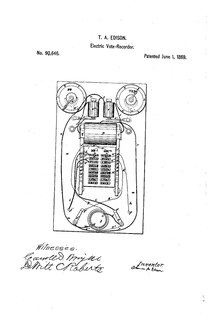Edisonsfirstpatent.png

Summary
| Description Edisonsfirstpatent.png |
English:
Electrographic Vote-Recorder, Thomas Edison's first patent. Permitted a "yes" or "no" vote via one of two switches. Washington congressmen were not interested in the device and the invention was a failure. (1869)
|
| Date | |
| Source | U.S. Patent 0,090,646 |
| Author | Unknown, but it's Thomas Edison 's first patent. |
| Other versions |


|
Licensing
| Public domain Public domain false false |
|
|
In general
,
the contents of United States patents are in the public domain
.
In specific cases , patent applicants and holders may claim copyright in portions of those documents. In those specific cases, applicants are required to identify the portions that are protected under copyright, and are additionally required to state the following within the body of the application and patent (see 37 CFR 1.71(d) & (e) and 37 CFR 1.84(s) , and MPEP § 608.01(e) & (w) and MPEP § 1512 ):
The original patent should be checked for the presence of such language before an assumption is made that the contents are in the public domain. (This template can be replaced by {{PD-US-patent-no notice}} in such cases.) |
